Homesteading isn’t just for those living out in the country; if you live in the suburbs, you can be a homesteader, too.
If homesteading is your dream, don’t wait for the perfect time or the perfect place to start your homestead, start right where you are and make small steps in the direction you want to go. Here are the basics of everything you need to know about suburban homesteading.
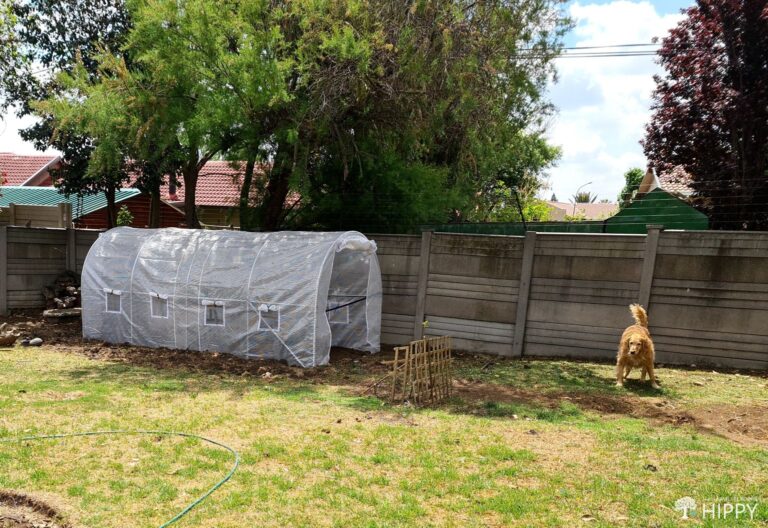
Homesteading is a lifestyle that involves being self-sufficient and living sustainably. No matter where you live, you can take steps to live more sustainably and more ecologically friendly.
Making a plan and taking small steps will help you move towards a more sustainable and self-sufficient suburban lifestyle.
You can homestead anywhere, whether you live in an apartment, a house with a small backyard, the woods, or the country. Homesteading in the suburbs involves making choices that help you live a self-sufficient life that is sustainable and ecologically friendly.
Table of Contents
Reasons to Become a Suburban Homesteader
Not every person has the means, or even the desire, to move to the country, the mountains, or the back woods to start a new life or live off the grid.
But that doesn’t mean you can’t be a homesteader if you live in the suburbs– there are many reasons to homestead, even in the suburbs.
You get to stay where you are.
You can homestead right where you are – no need to move from the home you love or go into deep debt trying to purchase the perfect property. Just start with what you have, whether it is an apartment with a balcony or a home with a small backyard.
You can build a community, and meet new people.
You can build community through homesteading, by working together with your neighbors, sharing food, and sharing skills. You’ll learn to help and depend on each other, as well as foster new friendships.
Of course, the best way to achieve this is to look for communities where people are already homesteading, especially if you are going to be introducing livestock into your neighborhood.
You may need to adjust your expectations based on municipal code or you may need to find a place outside the city rules and settle for a longer commute to work. Defining what is most important to you will help you decide where you want to live.
Increase food security.
By learning to grow your own food, you can increase food security in your neighborhood, especially when you share with others in need.
You won’t be dependent on the grocery store all the time if you have your own meat, eggs, and milk. You can share your skills with others, which will help them increase their own food security.
Live more sustainably, with less impact on the environment.
Making sustainable choices is good for the environment locally and globally.
Choices such as riding a bike rather than driving, staying home and gardening instead of going out to eat, and even reducing waste by recycling and upcycling all have positive impacts on the environment.
Reduce debt, and eventually get out of it.
Homesteaders learn ways to save money, which can help you get out of debt and build savings.
Use it up, wear it out, make it do, or do without is a common saying that helps you get the best use of what you already have so you don’t waste money on something you don’t actually need. Growing your own food will save money, and reduce trips to the store.
Learning new skills.
If you want to homestead in the suburbs, you can still learn interesting skills such as cooking, gardening, sewing, weaving, and woodworking. Many of the skills our grandparents used daily are being lost, but we can revive them even when we live in the suburbs.
Living a life that is prepared for emergencies.
If you are homesteading, you can also learn to be prepared for emergencies, such as power outages, snowstorms, and even pandemics that force people to stay at home or make supplies hard to find.
Eat healthy, local food.
Eating local is good for the environment and for your body. Eating food right after it has been harvested means there are more nutrients available for your body to use. Food that is locally grown saves on shipping costs and carbon emissions.
Challenges of Homesteading in the Suburbs
Although the benefits of homesteading in the suburbs will most likely outweigh the challenges, there are a few things you need to take into consideration before beginning your journey of suburban homesteading.
Space
One of the biggest challenges of homesteading in the suburbs is having enough space to accomplish your goals. It might be difficult to grow all the food you eat in a small yard, but there are many forms of gardening that will help you accomplish your goals.
Intensive gardening and soil building will help you make better use of the land that you do have.
You can also look for community gardens, rent or simply use space from a friend or neighbor, try vertical gardening, and choose vegetables that take up the least amount of space.
You can grow lots of your own food in a space as small as a tenth of an acre, so there is no reason not to try homesteading even if your property is small.
In fact, living on a smaller property can help you use it more wisely. Extra acres can just be wasted space that requires extra maintenance.
Township Laws and HOA Rules
Laws and rules may be the biggest limiter of suburban homesteading. Make sure you research the laws where you live because otherwise, you might incur hefty fines and lose your animals.
For example, your HOA may limit gardens to the backyard only. Some townships will only allow you to have farm animals if you have a certain amount of space to keep them on.
Some cities may allow you to raise rabbits or quail but not chickens, or a township might permit a couple of hens without roosters.
Other townships may require permits for building structures such as greenhouses or sheds, but might not require a permit for temporary structures such as hoop houses.
20 Ways You Can Homestead in the Suburbs
If you are going to homestead in the suburbs, first you need to figure out what is important to you and your family.
Perhaps starting a garden is important to you, but composting is not. Or maybe upcycling is the key to your sustainability, but you don’t like raising animals.
You’ll need to figure out which parts of homesteading appeal to you and start there. Here are some ideas on how you can homestead in the suburbs.
Start a garden.
It isn’t uncommon to see gardens in the suburbs. Whether it’s a small garden on the side of your house, a big garden in the back yard, or a small raised bed next to your patio, gardens are usually accepted and welcomed in suburban neighborhoods.
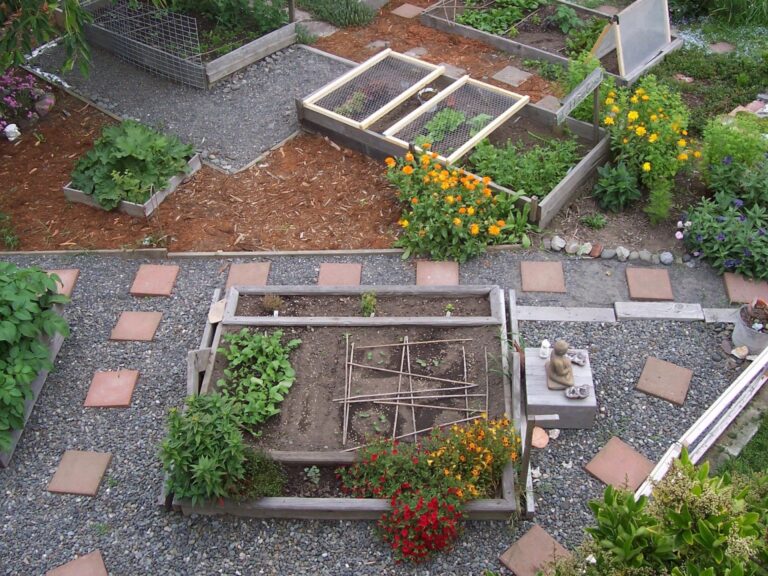
But you don’t have to grow it all yourself. You can share ideas with your neighbors and trade your extra produce for theirs. Choose to grow vegetables that your family likes to eat or your garden will be wasted.
Consider growing items with a small footprint, such as salad greens, radishes, and cherry tomatoes. Grow vining plants vertically, such as cucumbers, melons, pumpkins, or squash.
If you don’t have much space, you can still find room for some container gardening on your patio or balcony. Many types of vegetables, such as cherry tomatoes, salad greens, and radishes, will grow just as happily in a container as they will in a traditional garden.
If that doesn’t work, you might consider hydroponics and aquaponics. You can easily set up pre-fab kits, or make your own setup.
Small set-ups will easily fit a kitchen counter or side table, while larger versions can be used in your basement or garage with grow lights.
Plant fruit trees.
Fruit trees are a long-term investment, but they will provide you with a nearly effortless source of food.
If your HOA allows fruit trees in your yard, do some research to find out what varieties of fruits grow best in your location and if they need other fruit trees nearby to pollinate them.
If your yard is small, you’ll likely want to invest in dwarf trees for a smaller footprint and an easier to reach harvest.
Attract pollinators and beneficial wildlife.
By planting a pollinator garden or locally natural plants, you’ll be helping the wildlife in your community. You’ll provide food for bees, which will also pollinate your garden, and birds, and beneficial insects, as well.
Try beekeeping.
In a small yard, you can easily host a couple of beehives for honey. Honey keeps indefinitely, but you can also sell it locally to increase your income. Even if it’s not the right time to begin, you can at least start learning.
Edible landscaping.
One method of adding food-growing plants to your property is to use edible landscaping. There are many plants that can be grown for their looks – and for their food purposes.
For example, sunflowers, Jerusalem artichokes, nasturtiums, and chives are often grown for their pretty flowers, and for their ability to produce food.
Asparagus is delicious to eat, but also provides pretty, fern-like greenery which looks great as a backdrop to any flowerbed. Even if you aren’t permitted to have a garden, it may be perfectly acceptable to incorporate some edible landscaping into your yard or flowerbed.
Start a compost pile.
A compost pile is a great way to turn certain kitchen scraps into soil-building fertilizer.
If an open compost bin is not permitted, there are many commercially made or DIY compost tumblers that look nice and don’t attract unwanted pests.
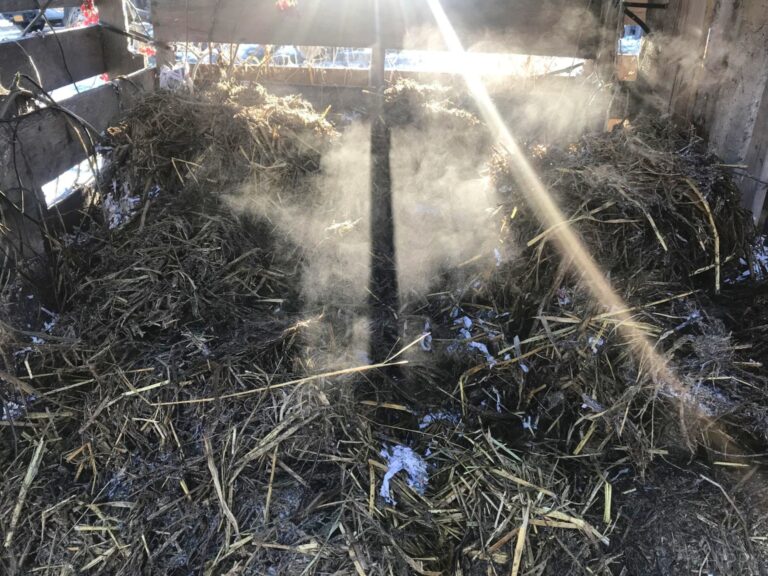
You can compost almost any uncooked fruit or vegetable scraps, eggshells, and used coffee and tea grounds.
Start a worm farm.
Worms are great for the soil, but worm castings are even better. Small worm farms can be started in your basement or garage and when taken care of properly, will not emit any odors or noises.
You can use the worm castings to fertilize your own plants or sell them to other gardeners to increase your cash flow.
Reduce, Reuse, Recycle.
We should all be doing what we can to protect the environment. Sustainable living means we do as much as possible to reduce, reuse, and recycle. You can do this anywhere you live.
Upcycle.
Turn your trash into treasures by upcycling old clothes, broken furniture, or trash into new objects for your homestead. For example, old rain gutters can be turned into vertical gardens and old pickle jars can be used to store dried beans or rice.
Join a CSA and shop local.
You can support local farmers and enjoy local, healthy foods by joining a CSA. Locally available food is better for your body and for the local environment.
Grow what you eat.
If you keep a couple dairy goats, you’ll never have to worry about running out of milk. If you love strawberries, you can grow them on your patio.
Growing your own food doesn’t mean just eating beans and peas – you can grow all kinds of foods that your family loves, even in a small suburban garden.
Learn how to preserve food.
You may not have enough space to grow all the food you need for your family, but you can purchase locally available food and preserve it to eat all year.
You might pick local strawberries or peaches to make jam, freeze green beans from your local farmer, or can spaghetti sauce made from tomatoes you grew on your patio. You might try some of these different methods for preserving food:
- Canning
- Smoking
- Freezing
- Dehydrating
- Freeze-drying
- Pickling or Fermentation
- Root Cellar Storage
- Preserving in Salt or Sugar
- Waterglassing Eggs
- Preserving in Alcohol
Keep emergency supplies on hand.
You never know when the next snowstorm, power outage, or flu will strike. Keeping emergency supplies on hand, and knowing how to use them, will help you be prepared for anything.
A generator will go a long way in keeping your refrigerator running and your lights on. Having a few solar panels is sustainable and will provide electricity during a power outage.
Some emergency supplies you might need:
- First aid kits
- Flashlights and batteries
- Extra cell phone, walkie-talkies, or other means of communication
- Generator
- Solar panels
- Bug out bags (supplies to take on the go)
- Emergency food supplies
- Firestarter and kindling
- Hand-crank radio
- Extra clothes
- Water
- Pet supplies
- Hygiene Items
- Cash
- Maps and Contact information
- Baby Supplies
Learn about permaculture.
Permaculture is a sustainable way of growing a garden. It involves natural means of soil building, such as composting, worm castings, and green mulch.
It means growing crops that are well-suited to the local environment and work well with the natural rhythms of nature. It means harvesting seed saving, and preparing the soil to be used again.
Back to Eden gardening.
Back to Eden gardening is a means of using wood chips to build soil. By applying wood chips each year, the soil grows as the wood chips decompose and fertilize the soil.
Wood chips also help to retain moisture, reducing the need for watering and irrigation. Wood chips can be attained from local arbor companies.
Practice seed saving. The best seeds are the ones that come from your own garden. If you have planted heirloom crops, you can save your own seeds from the very best plants and use them to grow plants the following year.
This is both sustainable and ecologically friendly. Over the years, your crops will improve if you always plant the best seeds from the best plants.
Rainwater Collection.
Although some locations have regulations against it, in most places you are free to collect rainwater. The easiest way to put a rain barrel underneath a downspout, but there are other ways to collect rainwater, as well.
It can be used for watering and irrigation ,but should be purified before being used for consumption.
In some areas, you can also use gray water, or water from your washing machine or dishwasher, to irrigate lawns. You should always check your local laws, and consider safety precautions when doing so.
Raise animals legally and ethically.
Animal husbandry can be an important part of homesteading, even in the suburbs. Some places will allow you to have goats, chickens, rabbits, or even quail, depending on the laws where you live.
Some animals you might want to raise on your small homestead are:
- Rabbits. Rabbits are a great source of meat. But even if you can’t bear to eat your furry friend, you can raise them as a great source of fertilizer or manure, for companionship, to show, and to sell as pets.
- Quail. If your space is very small, consider raising quail. They have an excellent feed-to-egg ratio, make little noise, and take up very little space. You could raise a couple of quail in the corner of an apartment if you chose. Quail can often be raised even in areas that do not permit chickens.
- Goats. Goats require a little more space than other animals, but if you raise Nigerian Dwarf Goats, they won’t take up too much room at all. A small shed and a little space to run around is about all they need. Goats are a great source of milk and meat. Some goats are raised for their wool.
- Chickens. Many locations have ordinances against chickens, so you will need to do your research. Of course, chickens are a great source of meat, eggs, and fertilizer. They will also take care of most of your kitchen scraps for you.
- Tilapia. If you have a water feature in your yard, you might want to add some tilapia to it. Raising tilapia is a great way to add fish to your diet.
- Alpacas or llamas. These animals make good pets, and are a great source of fun and wool. They do require a little extra space, but if you have a large backyard, it might be just right to house a couple of these beauties.
Always raise your animals legally and ethically, and be sure you’re ready for them before you buy them. Before you run to the nearest farm for a new animal, you need to consider:
- How you will feed your animals? Some animals need hay, grains, or other types of feed. Do you know what these animals need, and where to get it?
- Where you will house your animals? Every animal has its own housing requirements, including indoor and outdoor space, bedding, and companionship.
- How your animals will get exercise. Animals need some type of exercise. Will you allow them to roam a pen, walk on a leash, or have a larger cage?
- Will butcher them for meat, or raise them for milk and eggs?
- What you will do with animals that are no longer providing you with food? Will they live on your homestead as pets, will you butcher them, or will you sell them to someone else who will?
- Vet care and grooming availability and cost. Every animal will need some kind of veterinary care. They may get sick, need to be neutered or dehorned, and some animals will need to have their hooves taken care of and be dewormed.
- Manure disposal. Every animal makes some sort of excrement. How will you dispose of it?
- Storage. Where will you store the things that your animals need, including food, grooming items, leashes, and extra bedding.
- Predators. What kind of predator protection do your animals need? How will you provide it?
Best Practices for Homesteading in the Suburbs
Keep the neighbors happy.
Keep your neighbors’ needs in consideration when you plan your homestead. Noisy animals, odors, or just generalized messes in your yard can create contention between you and the people who live nearby.
Be polite and let them know if you’re going to be doing any major construction (such as putting up a fence or building) and try to make friends with those nearest you.
It doesn’t hurt to share your eggs, produce, or craft items as a way of bridging the gap to create supporters of your small homestead.
Keep your property neat and tidy.
HOAs often have rules about how your property needs to look, but even if you don’t have an HOA presiding over your neighborhood, you may want to take extra care to keep your property neat and tidy.
Not only will it keep the neighbors happier, it will also prevent your home from being an eyesore for passersby.
Keep rodents under control.
Animal feed and waste attract rodents and pests. Your neighbors will not be happy if your homestead attracts pests to the area, so take care to prevent them from coming in the first place. Keep animal feed in metal containers and dispose of waste properly.
Keep odors under control.
Don’t let compost, manure, or waste get out of control. Farm animals can have odors if they aren’t well taken care of, so do your best to keep your area clean and free of odors and bad smells.
Clean up messes, don’t let old chicken food get wet and rot, and always take care of manure.
Keep your animals in your own yard.
If you want to keep your neighbors happy, invest in a good fence. They may be very upset if you allow your animals to roam free in the neighborhood, digging in other people’s gardens, or eating their favorite flowers.
They will be less inclined to call the authorities and complain about your animals if they are where they are supposed to be.
Final Words
Homesteading in the suburbs can be as simple as growing a few tomatoes on your back deck, or keeping an herb garden on your windowsill.
It involves making daily choices to be more sustainable, more frugal, and more ecologically friendly in your comings and goings.
It means learning skills that will keep you safe, healthy, and well-fed during emergencies, and it is a way of life meant for slowing down a little bit and taking in the beauty of the natural world around us.
It is a means of living in concert with the environment; the earth will easily sustain us if we provide, and care for it.
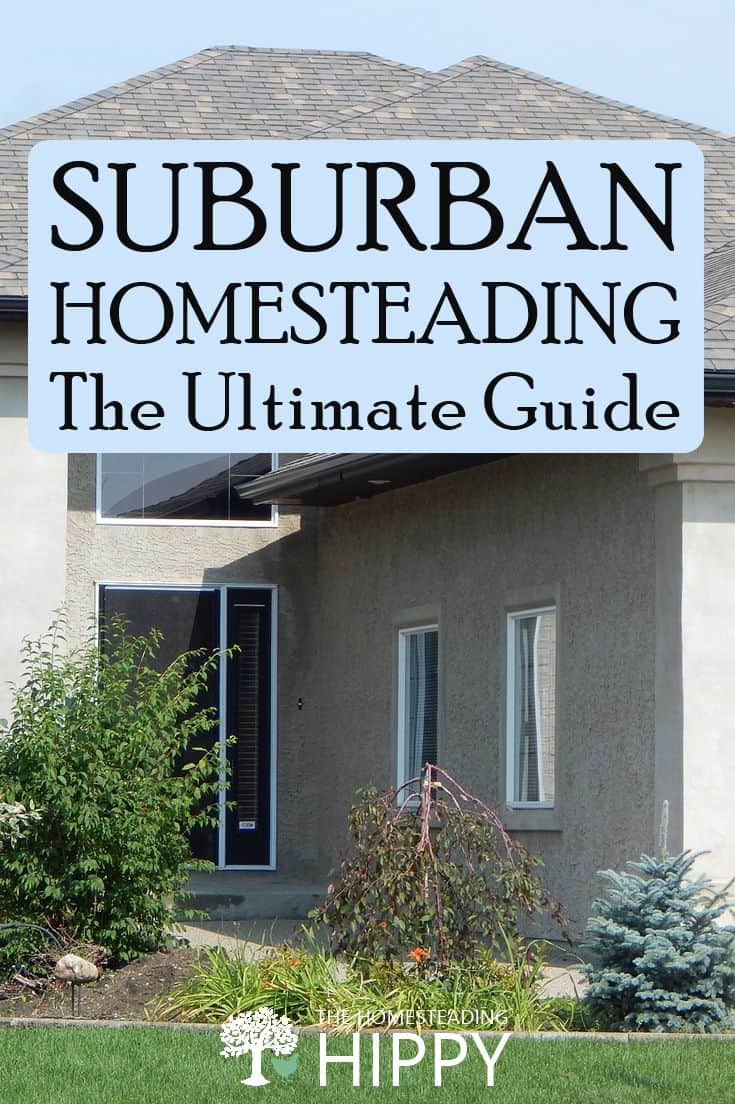
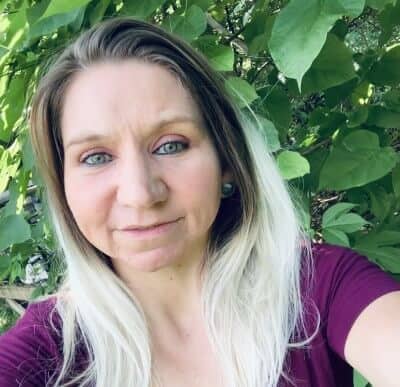
Amanda is a homesteader and a Jesus-loving, mother of 6 toddlers. She’s raising lots of fancy chickens and goats on her small homestead (among other things). Find out more about the team here.
